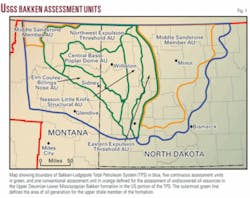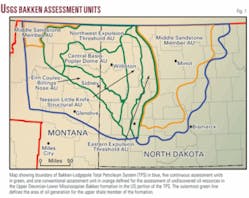The Upper Devonian-Lower Mississippian Bakken formation in North Dakota and Montana, which has produced 105 million bbl of oil through the end of 2007, contains an estimated 3 to 4.3 billion bbl of undiscovered, technically recoverable oil, the US Geological Survey said Apr. 10.
This is 25 times the USGS 1995 assessment of the amount of oil that can be recovered from the formation. It is “larger than all other current USGS oil assessments of the Lower 48 states and is the largest ‘continuous’ oil accumulation ever assessed by the USGS.”
The next largest continuous oil accumulation in the US is in the Cretaceous Austin chalk of Texas and Louisiana, with an undiscovered estimate of 1 billion bbl technically recoverable.
The mean value for the Bakken is 3.65 billion bbl of oil, 1.85 tcf of associated-dissolved natural gas, and 148 million bbl of natural gas liquids. This volume is judged to be producible using available technology and industry practices.
“New geologic models applied to the Bakken formation, advances in drilling and production technologies, and recent oil discoveries have resulted in these substantially larger technically recoverable oil volumes,” the USGS said.
Five continuous assessment units (AU) in the southern Williston basin were identified and assessed. They are, with mean resource values: Elm Coulee-Billings Nose 410 million bbl, Central Basin-Poplar Dome 485 million bbl, Nesson-Little Knife Structural 909 million bbl, the Eastern Expulsion Threshold 973 million bbl, and the Northwest Expulsion Threshold 868 million bbl.
At the time of the assessment, a limited number of wells have produced oil from three of the assessment units: Central Basin-Poplar Dome, Eastern Expulsion Threshold, and Northwest Expulsion Threshold.
“There is significant geologic uncertainty in these estimates, which is reflected in the range of estimates for oil,” the survey said.
A mean resource of a conventional 4 million bbl was estimated for a hypothetical Middle Sandstone Member assessment unit on the play’s northwest and eastern extremities.
Elm Coulee field in Montana, discovered in 2000, has produced about 65 million bbl of Bakken oil (OGJ, Dec. 11, 2006, p. 42).
The USGS worked with the North Dakota Geological Survey, a number of petroleum industry companies and independents, universities, and other experts to develop a geological understanding of the Bakken formation.
“The assessment of the Bakken formation indicates that most of the undiscovered oil resides within a continuous composite reservoir that is distributed across the entire area of the oil generation window and includes all members of the Bakken formation,” the USGS said. That refers to the lower shale member, middle sandstone member, and upper shale member.
The upper and lower shale members of the Bakken formation are also the source for oil produced from reservoirs of the Mississippian Lodgepole formation.
“Most important to the Bakken-Lodgepole Total Petroleum System and the continuous assessment units within it are the geographic extent of the Bakken formation oil generation window, the occurrence and distribution of vertical and horizontal fractures, and the matrix porosity within the middle sandstone member,” the USGS said.
The Bakken also underlies parts of Saskatchewan and Manitoba, but the USGS did not assess the Canadian portion of the basin.
Most active operators in the US Bakken play so far include Continental Resources Inc., Headington Oil Co., Lyco Energy Corp., EOG Resources Inc., ConocoPhillips, Marathon Oil Corp., Petro-Hunt Corp., Whiting Petroleum Corp., and Hess Corp.


